My shady yard, help with ideas, please?
I'll include more pictures below.
This is my southern Vermont yard. It's facing north, gets very little morning sun from the front due to a huge hill across the street and the fact that I am in a deep valley. In the mid-day, it gets ZERO direct sun, it is totally shaded all midday as the sun just stays on the other side of the house, it's 2 story, so the building blocks all the sun midday. In the evening, it gets sun to filtered sun where the bushes do not cover it entirely in their own shade, from after 4pm til about 7 pm when the sun goes behind the other side of the valley. Even then, the bed close to the house barely gets any sun. I am in zone 4, but I generally have ice and snowbanks covering everything til mid-March, so it's a shorter growing season for me than others in the same zone. The only thing I have flowering so far is a wild bleeding heart and it is in the very back where there's the most sun, nothing is anywhere near blooming on this shady side, the lilies are only about 4-10 inches so far (depending on how much I trampled them when I dug out the knotweed).
Currently I have some big bushes/trees, and some perennials in the beds I am defining this year. Many have been moved twice in a year's time, and are struggling to come back, slowly. In the photos, I've ID'ed the bushes/trees to my best knowledge, and could use help ID'ing them. In the beds are lily of the valley, daylillies, ferns, bleeding hearts. The daylillies are the only ones showing so far on this shady side of the house. I do have some plans, and would love ideas or at least, tell me if they are BAD ideas for my space.
I'd like to define the lawn better, add more grass seed, including some clover, bluegrass, and fescue. Other grass suggestions would be helpful. It is very thatched and I do not have access to a dethatcher or roller or aireator. If I can do it by hand, I will. I do not know where to END the lawn, or how. I'll include a photo of my possible ideas for where to end the lawn. The entire time I have lived here, much of this has been barren DIRT, hard packed, nothing grows on it. It's under a very old hydrangea, and the roots of that are very shallow, so it is very hard to plant anything under it. I can add a layer of soil/peat/whatever, but I don't want to harm the ancient hydrangea in doing so (it is ancient, so tips on how to keep it alive longer are appreciated too).
I'm thinking in the front part, I'd like to establish a low growing groundcover over where this bare dirt is now, and just merge it to grass at some semi-logical point, which I have not determined just yet. However, I could just put mulch on top of the bare dirt, if it's likely no groundcover will grow there. I was thinking for the groundcover part, like under the hydrangea, where the burberry bushes will be dug out (waiting for the landscape company guy to chainsaw the tops off so the thorns don't get me during the digging out), around the forsythias, and under the oil spout/cablebox perhaps wintergreen, wintercreeper (taller than I'd really like), aubrieta, viola, catmint, catnip. Any combination of those (I honestly was going to plant them ALL and see which one did the best). Do any of those sound logical for mostly shade? I read somewhere that the color the hydrangea blooms tells the soil ph, and mine blooms pink/white, so that means my soil is alkaline. I do not know if this is true, but it's probably likely.
Then, for the part nearer the house, I was thinking a combination of caladium, coleus, helleborus, trillium, ferns, and violas. I don't want hostas, I already have them in the front and there's already too many. I can't think of any other shade loving plants that will survive my winters (not sure even all of those will for sure). I don't plan to remove the existing liles or lily of the valley, rather, I want to supplement them, and add cool colors (pinks, blues, purples). I don't care how high it grows, though I'd prefer it be between 10 inches and 30 inches tall, no taller. I sure would like to get something flashy like lupines or columbines, but I think it's not enough sun, is it?
Comments (46)
Jules (5a S.E. VT.)
Original Author10 years agolast modified: 9 years agoJules (5a S.E. VT.)
Original Author10 years agolast modified: 9 years agoRelated Professionals
New Bedford Landscape Architects & Landscape Designers · Clark Landscape Architects & Landscape Designers · White Oak Landscape Architects & Landscape Designers · Arlington Landscape Contractors · Deerfield Landscape Contractors · Kearny Landscape Contractors · Middletown Landscape Contractors · North Richland Hills Landscape Contractors · Rochester Landscape Contractors · Siloam Springs Landscape Contractors · Blue Springs Decks, Patios & Outdoor Enclosures · Grandview Decks, Patios & Outdoor Enclosures · New Lenox Decks, Patios & Outdoor Enclosures · Parker Decks, Patios & Outdoor Enclosures · Pittsburgh Decks, Patios & Outdoor EnclosuresJules (5a S.E. VT.)
Original Author10 years agolast modified: 9 years agoMy captioning text on those images is really small, sorry, if you can't read it, just ask. The tree in the back, I would like to identify. Here are some images of it closer. I didn't get any of it while in bloom last year *derp*! It has really nice big clumps of fragrant flowers that looks sort of purpleish/pink/green/white (very hard to describe color). The leaves are sort of shaped like hearts, and about palm-sized, deep green. I think *maybe* it's a very very old lilac???
Jules (5a S.E. VT.)
Original Author10 years agolast modified: 9 years agoJules (5a S.E. VT.)
Original Author10 years agolast modified: 9 years agoJules (5a S.E. VT.)
Original Author10 years agolast modified: 9 years agoThe tree to ID, last summer after the blooms dropped (like flower snow on the grass, just so so pretty). Shows the mature leaves, but not the intact flowers which I neglected to photograph *derp*! The smaller one that's growing out of the big one's extremely invasive root system does not yet bloom.
You can also see how I changed the outline of this bed, making it straight instead of curving out around the rhododendron. You can also see that the grass that does grow is really nice grass, and I'd just like more of it, and to fill the bare spots I made when I levelled the lawn this spring and dug out rocks/fenceposts.
terrene
10 years agolast modified: 9 years agoPhaewryn, your "tree" with the fragrant flowers is common Lilac, Syringa vulgaris. Brought over from Europe hundreds of years ago, it is a hardy shrub and not invasive. It will sucker and spread in a clump, and if you want to rejuvenate the clump you can cut back a few of the oldest stems to the base, and it will send up new shoots. But then it takes a few years for the new shoots to flower.
Lilac blooms are one of life's great pleasures IMO!
prairiemoon2 z6b MA
10 years agolast modified: 9 years agoHi Phaewryn,
You’ve offered a nice detailed account of your property and what you are trying to accomplish. Adding photos helps so much. I love your house, a really nice size and all those windows. I also like the color combination of the siding and the shutters.
I was able to read your captioning by clicking on the photo and increasing the size of the text on my browser.
You have my sympathies to have so much shade on your property, which will limit your choices, and I have yet to meet someone with a shady garden that wasn’t wishing for full sun, but you can have a very nice garden even in the shade.
I will try to give you some help, but I’m not an expert with some of the questions you have. I do feel confident though to tell you that how great a garden you can grow depends a lot on the health of your soil, so that would be the place to start, is to build up your soil. I can’t emphasize that enough. It would be great if you could get a soil test to start off too. The time you spend learning about soil and how to keep it healthy in an organic way, will reward you for your investment.
Questions and comments on your post…
I’m in zone 6 and my Bleeding hearts are not even blooming yet and my lilies are only up about 4 inches too. It’s been a long winter.
I don’t know anything about knotweed, is it something that you can be sure is gone after digging it out, or is there a chance it could come back?
How long have you lived in that house and have you been gardening there or is this your first season gardening?
Do the daylilies bloom for you?
About your lawn…yes, it is rather patchy and my guess is that your soil may be compacted. I think there is a lot you can do to bring the lawn to better condition and I would suggest you spend some time over on the Organic Lawn Care forum. I’ve heard some very interesting suggestions they’ve made. One being using alfalfa meal to condition the soil and restore health. I like your idea of reseeding using grass seed and clover, but I don’t really know what kind of preparation you’d need to do first, or which kind of grass seed would do best in your shady conditions. They will know on the OLC Forum.
As for the shape of the lawn, I think that it should be a combination of what appeals to you and what is practical. In your photo, the one determining factor may be the Rhododendron. You can see grass has had a hard time growing under it. You might want to curve the edge of the lawn to go around the Rhododendren and either fill in with bark mulch under it, or find a ground cover that will work there. If you curve it there, you might want to curve all the corners too. If you would rather have straight lines, you’d have to ask if it’s possible to grow lawn under the Rhodie once the soil is improved.
I would not rely on the color of your Hydrangea indicating that your soil is alkaline, only because your Hydrangea appears to be a paniculata not a macrophylla which is the one that would be either blue/pink depending on the soil PH. The paniculata would normally be white with some pink, not blue. And from the photo #3, it appears to have some major holes in it. Not sure what to suggest for that, but I would ask on the shrubs forum for advice. I’m not sure whether it could be rejuvenated? I might consider replacing it with another Hydrangea of the same variety if possible?
I agree with Terrene that your ‘tree’ is a lilac bush that is old and tall and you’re very lucky to have it. And it looks healthy, just might prosper from a little expert pruning. I like the tree form. It’s a lot taller than some I’ve had. I wonder how you manage to get bloom on a lilac with all your shade? Also if you want more blooms, you might want to deadhead it after blooming, meaning to cut off all the dead flower heads before it sets seeds and it will produce more flowers the next year.
As for the list of plants you would like to use. Wintergreen, may need better soil and might also need a certain PH. I’d check on that one. Wintercreeper, [Euonymous] I have no experience with. Catmint, may need more sun. It definitely will flop even if it did bloom, if there is not enough sun. Viola will reseed into your lawn and around your yard. Aubrieta is a rock garden plant that may need more sun, I think.
Caladiums, Coleus, Helleborus, Ferns, Violas, all should grow without trouble if the soil is improved. Trillium can be tricky. I don’t know the hardiness zones of any of those. Well, except Caladium which I believe is not even hardy in my zone 6. It is used and then ‘wintered over’ in the house or bought new like an annual every year. It’s too bad you don’t want Hosta because they are great in shade. I wonder if you have seen how many different types and colors there are now? Even if you added one or two to your plan, that would bring you interest and cover ground.
I would suggest to you the plant Epimedium which will grow in any kind of shade you have and is easy to grow and hard to kill. It’s also hardy to zone 3. It would go with a lot of your other plant ideas. Another spring bloomer is Tiarella which works as a groundcover and is a native too. You could also plant some spring bulbs, maybe not the daffodils in that amount of shade, but in your sunniest part, you could try a daffodil. Some of the smaller bulbs that grow in shade are something to look into. In your sunniest area, you might try Columbine, but probably not Lupine.
Okay…I hope something is helpful and keep asking questions.
Steve Massachusetts
10 years agolast modified: 9 years agodiggerdee zone 6 CT
10 years agolast modified: 9 years agoWell, despite what PM2 says - :) - there are some of us who LOVE our shade garden and don't want any more sun. Of course, we have family members who grumble something about us being vampires because of the way we shun the sun, but that's okay by me!
If this were my yard, I would bring the bed out further from the house, at least two more feet. It just seems too shallow for the house, especially with those big shrubs in it. I realize there's not a lot of room to go, but if you are having trouble with grass anyway, why struggle? Make the bed bigger, have some lush, lovely plants, and keep the grass to a minimum.
I encourage you to rethink hostas if you have not really looked into what's available. In addition to being a possible vampire, I'm a HUGE fan of hostas, and really have a hard time not buying them, especially if they are variegated. You can also grow azaleas, foxgloves, monkshood, astilbes, heuchera/heucherella and tiarella, geraniums, and boxwood in shade. You could always add more rhodies or hydrangeas (nice dwarf rhodies out there now) and there are nice dwarf pieris shrubs available as well. And bleeding hearts are always nice in spring - love the white ones!
Some things you might want to try, but might be iffy, depending on the shade situation, are phlox, montauk daisies, dayllies (hundred to choose from!), virginia bluebells, hellebores, and I even have some annual rudbeckias that do well in part shade (and reseed and sometimes even come back). I have some peonies in part shade that do well, and redtwig and yellowtwig dogwood, viburnum, itea, and clethra. My area does get about half-day sun, and is very moist, so these may not work for you in your spot, but perhaps futher research and a bit of risk-taking may prove me wrong! Heck, if you can get that lilac to bloom in shade, you might be able to do other things as well!
Groundcovers: I love wintergreen, but I find it expensive and I gave up trying to establish it on the northeast side of my house, as it just would not thrive. Too bad, as it's quite nice. I have had luck (too much, actually, lol) with rockcress in that spot. In other shady areas I have vinca (boring and common but effective and evergreen), and sweet woodrufff, which I really love, although some find it too aggressive. And ajuga is good in shade, although that too is aggressive, depending on variety. I've tried lamium, which is very pretty, but it seems to dwindle out after a year or two and I gave up on that as well.
Another quite pretty groundcover is chrysogonum. Very pretty yellow flowers blanket it in spring. And perhaps a nice low-growing geranium would work - my personal favorite is biokovo and biokov Karmina.
As far as the lawn, I'm probably the wrong person to ask as quite frankly I don't care about the lawn! But, realizing that a nice lawn does set off the garden beds nicely, I have decided to pay attention to my lawn this year. I garden organically, so my plan is to rake up the thatch, spread about a 1/4 inch of compost, and spread some shade-tolerant grass seed. I have a large yard so I'll have to do this in sections.
My yard is so shady I have huge patches of hair-cap moss, which I actually LOVE (my neighbors spend lots of time and money trying to rid their yards of it, although they have more sun so less moss), but this stuff is so soft, and evergreen, and never needs mowing. I think if I actually had as small a lawn as yours I might try to make it all hair-cap moss, although I think it thrives in a more acidic spot than what you look to have. I don't intend on removing it and will re-do the lawn around the existing patches of moss.
Whatever you do, I would definitely put a nice layer of compost on the bed, and a nice layer of mulch on top of that, to start with.
Good luck! Please let us know what you end up doing!
Deediggingthedirt
10 years agolast modified: 9 years agoI completely agree that the beds should be quite a bit wider. I'd like to suggest that you pick up one or two of Gordon Hayward's design books - he's got some straightforward ideas about proportions that even a math-phobic gardener like me can understand. Your library should be able to get these for you.
Other great shade plants include gingers and epimediums. Both are easy to grow; the gingers do prefer richer soil and more moisture, IME, so I'd start them well away from the house wall.
To avoid having too many fine-textured groundcovers, try some Kirengeshoma (which looks more like a shrub when it's leafed out) and the incredible purple-leaved Ligularia dentata. I have a variety of that one that's got GIANT glossy dark leaves with deep red undersides - really stunning.
Since it sounds like your lilacs bloomed last year, don't be too quick to condemn them! The patterns of the sunlight DO vary over the course of the seasons, so maybe they get enough light when they need it. If you cut them back you may cut off that access to the sun - personally, I don't think old lilacs really need pruning.
Love your house - it's really charming. Good luck with this project, and please keep us posted!
Here is a link that might be useful: Gordon Hayward's site
diggerdee zone 6 CT
10 years agolast modified: 9 years agoAh yes, DTD reminded me that I meant to comment on your house as well. It looks lovely! I'd love to see some photos of the whole house.
I was going to mention ginger also for a groundcover, but didn't remember enough about it to recommend it. I've always loved the look of it, and did look into it years ago for my garden, but it seems so darn expensive I turned to other things -like my failed (expensive!) wintergreen, lol - maybe I should have tried the ginger after all!
Dee
prairiemoon2 z6b MA
10 years agolast modified: 9 years agoI knew there was something about the lilac that I felt conflicted about and you hit the nail on the head DtD. It is blooming! In such a shady yard, and that may well be because it is tall enough to reach the sun. I like the way it looks so tall and it looks more like a small tree that way. I wouldn't take the height down either. You wouldn't want to lose the ability for the shrub to bloom.
I also love European Ginger, a very easy care plant IME, slow growing. Dee, I avoided Wintergreen because of reports of it being finicky. I did try Gaultheria which is also expensive and not that happy with it's performance. One that I just LOVE, is Arctostaphylos, which has grown and spread and always looks great. The one problem it has, is that the leaves get stuck in it and I have to pull those out in the spring. But for me it's quite worth it. I just bought some more.
Started_with_bean
10 years agolast modified: 9 years agoHow about Solomon's Seal? It grows well in the northern part of my yard, and is a perennial that gets little care or watering at all. English Ivy could be a choice for ground cover and is really hardy/invasive for me even in the deep shade. How about Astilbes and Coral Bells?
diggingthedirt
10 years agolast modified: 9 years agoCoral bells (heuchera) is a great idea - some of mine are in fairly deep shade and seem happy. I'd stay away from ivy in all its forms, because I'm in a battle to the death with it, and I know it's winning. That might be because I'm in zone 7, of course, and it may be fine in Vermont (just don't trust it!). Lady's Mantle is great in shade, too.
I've bought really tiny European gingers - 3 inch pots - and really pampered them with plenty of water and good soil for awhile. Once they're established, they spread very nicely. The larger-leaved and speckled ones, some of which I guess are not true asarums, are great too.
jillyluis
9 years agolast modified: 9 years agoI'm with diggerty I think it was. I LOVE my shade garden...it is a 1,000 times easier to maintain than my sunny spots. I would strongly suggest a wonderful book on perenials called "Making the most of Shade" by Larry Hodson. Also, carolynsshadegardens.com has some fun blogs and posts. She does a nice list of shrubs and occ trees .Look for "plants for shade Part 1 through 10."
Good luckcasey1gw
9 years agolast modified: 9 years agoI love my shade garden. I wish I had more shade. In it I grow: hostas, Japanese painted ferns, epimediums and gingers in the front. Also heucheras and tiarellas for the colorful foliage, astilbes and aruncus diocus with feathery foliage and taller flowers.; phlox divaricata, lamium and sweet woodruff weaving through; hellebores for early spring with smaller bulbs and daylilies and kirengeshoma on the side with more sun. In the worst soil, I have euphorbia amygdaloides but have to pull up the wayward stems.
Jules (5a S.E. VT.)
Original Author9 years agolast modified: 9 years agoThanks so much to everyone who replied! I just got back in town (and on my computer), and wow, so much advice! I'll try to get back to everyone's specific suggestions and/or questions. As for the lilac tree/bush, yes, it blooms! It's in the very back, it is what creates the shade that makes everything else shady in the evening. It starts getting sun at around 4pm, and somehow, that seems to be enough for it. I am worried because it has one trunk that has a 1/8-1/4 inch hole bored into the center of it, and part of the porch was eaten by some insect last year (I have no idea what, because my landlord is in denial that a problem exists, and simply patched the porch and painted over the damage - yes, I rent here, but I have his approval to landscape as I wish). I don't want to cut it back at all, but if whatever that was bores into it again this year, I may have to prune it back to get rid of the pests. It is lovely, and it hangs over my back porch, and I have no intention of removing it, unless I absolutely have to because it gets infested with something I can't kill any other way. But, that lilac (thanks for verifying that is what is indeed is) is what makes the entire bed under it shady in the late day, as it basically is a tree that blocks most of the sun after the sun moves behind the house around 4pm or so. Further down, the huge rhododendron does the same for the rest of the bed closer to the front. The big bushes basically knock out any sun it might get. I'll try to get my boyfriend to take a photo of me in the frame for scale, these are HUGE bushes, the window frame bottom is about at head level, and these go way up above the window.
The ancient hydrangea in the front, I love it! Yes, it is old, beaten down, and the trunk has holes, but it's actually still coming back, and I think I will keep hoping it will continue to do so, and if it doesn't some year in the future - if its lifecycle is complete, I'll have it removed and the forsythia under it will most likely be happy to grow to fill any hole it leaves. I don't plan to "replace" it in any way, rather, I hope to conserve it as long as possible. That is why I was asking WHAT to put under it, if it's possible that one groundcover or type of mulch, or something specific might HELP it somehow, that is what I want to do.
I LOVE the shade, and that's actually why I don't make the bed wider... any wider and I wont have room for my lounge chair on the lawn in the shade in mid day. I can't get more than 20 minutes of direct sun due to medication I take, so that shady lawn area is very important to me. I also have a terrible phobia of slugs, so lawn keeps me safe from the slugs that might hide in a deeply bedded bed... and that leads to why I don't want hostas... the slugs hide under them, that is also why I tend to like things with smaller leaves/flowers, as I can SEE what's creeping in there and know it's not icky. It's a completely irrational phobia, I do know slugs are harmless to me, but that's how phobias work, they are irrational.
I wish I could get nice moss started, anywhere! In the beds, in the lawn, I love nice soft forest moss! I just think it's not quite moist enough for it, although I am petitioning my landlord for outside water access so I can water my beds/lawn this year. It's really tedious watering by the bucket, and that's one more reason why the beds aren't wider too, the sheer task of watering everything would become overwhelming. My boyfriend has some nice mosses in his yard, I'll try to steal some and try it once I have access to a water source outside.
My boyfriend has a whole hillside of lovely evergreen ground cover at his house that I stole several springs of today to try planting here. I have no idea what it actually is, but it looks a lot like wintergreen, except it creeps and doesn't berry. I'll post a photo of it tomorrow when I go to plant it. It covers his hillside under pine trees, so I'm not super hopeful, as I think pine trees grow in about the exact opposite of whatever I have here for soil (yes, I do need to get the soil tested, I will look into that cost). I also managed to get a small rooted cutting off one of his lilacs that I am going to try to plant, as well as several nicely rooted azalea shoots off his huge bush. Mostly, as you noted, I need to amend the soil badly. It needs compost and peat, and such. And the landscape guy I paid in cash to remove the thorn bushes still hasn't removed the thorn bushes! He'll be called tomorrow! I really expected him to have done that while I was out of town!
Oh, I can go dig up wintergreen for free out of the high school forest trails... I know where it grows as I spent several months camping out there. I just don't think it will take to the kinda barren soil I have here, where it grows is very loamy and rich naturally. Also, trilliums grow natively here as well, although they are protected, so those I WONT be digging up for free, but I found a place that sells the seeds, and I was going to give those to my super-green-thumb boyfriend to start for me at his place, where he has amazing things like orchids growing. If anyone can grow trilliums from seeds, he can. He now has lemon trees growing... in Vermont, as houseplants! I swear, anything I seed at his house and leave at his house grows, and he doesn't really even seem like he TRIES really. o.O We've begun putting every seed from anything we eat in a pot, and it almost always grows, although he thinks that my grand scheme of planting cantaloupes on his hillside is evil and a road hazard (he seems to be convinced that rebelling fruits will randomly jaunt down the hill, bounce up, and kill passing motorists, lol).
The knotweed: No, it's very doubtful I got it all out, it's extremely invasive and has huge root systems. The best I can do is keep digging up any that shoots up, and that is why I want just some sort of really strong groundcover there, because it may get dug up and replanted many times.
Your suggestions will be researched and I'll get back to you all, many of the things suggested, I simply do not know, so I need to go learn about them first! I'm not a native Vermonter (originally from Tennessee, so I don't know much about Vermont plants), I've only been here for about 9 years, and only in this place where I can landscape 2 years, well, this will be my second summer, so really, this is my first real year to garden in Vermont, as last year was more of just moving around existing plants and making the beds and such as I came in late in the season.
What I generally want is: small dark green leaves (groundcover), small flowers in pinks/fuchsia/lavender/purple/blue (I'm not opposed to bulbs, but they can't be toxic to cats, as my elderly brain-damaged cat [she was hit by a car as a youngling before she came to me] goes out with me on her leash, and isn't very bright when it comes to what to chew and what not to chew), and big flowering bushes/trees that require almost no care/attention. I was just throwing in the caladiums/coleus mix in because it says it grows in shade and it has lots of color, and it's a dark bed, and needs something to brighten it up, and I remember my grandmother grew a big pot of them, actually a wine barrel full of them. Also, I think I have a post traumatic stress association with hostas. They really really bother me, and I can't really put my finger on it, but my mom had them, and my ex-mother-in-law had them, and I just DON'T WANT them. They remind me of things I wish I could forget. I want to grow things my grandmother grew, not things my mother and mother-in-law grew. The problem is my grandmother lived in Tennessee and had some sun! I would love peonies and gardenias! *sigh
I'll do the best I can with what I have, though, she also had azaleas and caladiums/coleus, and I can take the caladium/coleus to my boyfriend for the winter as houseplants - his house logically faces eastern sun (and he lives at the TOP of the hill, not in the valley) and has big full sun front windows. Do you think, since I'll have to take them in for winter, that just planting a whole POT with them in it works? Then I can just dig up THE POT and dust it off and take it to his house in the fall? or is that really wishful thinking on my part?NHBabs z4b-5a NH
9 years agolast modified: 9 years agoYou have gotten lots of great suggestions, at least partly due to the clear photos and explanations of your goals and reasoning. I particularly like the suggestions of Solomon's seal, Tiarella, Heuchera AKA coral bells, and Heucherella since there are varieties of all of them with variegated foliage to brighten things up (since you don't like hosta, a common choice for many folks in shade.) I have a variegated Solomon's seal, green and white, that will gives some foliage variegation. It has medium leaves, but arches high enough that slugs/snails shouldn't be an issue. The Heuchera, Tiarella and their cross Heucherella all have medium leaves and spring to early summer flowers.
There is a spring-blooming small woodland iris, Iris cristata AKA crested iris, which is happy in shade and is available in blue and in white. It will slowly spread. In this photo, an area that only gets a very few hours of late day sun, the bright yellow is a deciduous Rhododendron narcissiflora, with Iris cristata above the yellow flowers, a Tiarella to the yellow flowers' right just starting bloom (and also one not yet blooming at the very top right) and European ginger (z 5) at the bottom left.
From 2013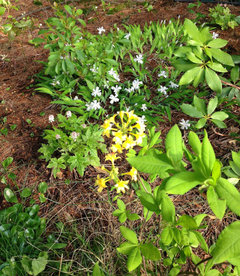
I grow Veronica 'Georgia Blue' (z 5) as a groundcover in mostly shade, and it should be fine with the amount of sun that lets your lilac bloom.
{{gwi:202703}}From May, 2011Likewise, cranberry AKA Vaccinium macrocarpon (z. 2 or 3) can be grown in ordinary garden soil and makes a great evergreen groundcover that weaves around other plants, though it isn't good at weed suppression. Vaccinium vitis-idaea var. minus (z. 2 or 3) AKA lingonberry or mountain cranberry is a shade-tolerant native with small white flowers and red berries.
A few of the plants suggested above, such as Pieris AKA Andromeda, aren't quite hardy enough for you, so be sure to check out hardiness from those of us who live in warmer areas. I have found it to be not worthwhile to push zones with shrubs since they take a long time to recover from a harsh winter. With perennials if you have good snow cover, you might try a few zone 5 perennials such as those given above or Hakone grass AKA Japanese forest grass or Carex 'Ice Dancer', which might do OK along the foundation where it's a bit warmer if given a good mulch of chopped leaves in the late fall to protect them before snow arrives. This photo has golden hakone grass with wild type columbine (easily started from seed).
From 2013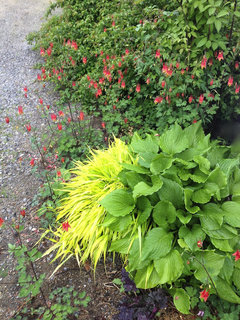
Where the knotweed was, I probably would plant things in pots, either on top of the soil or buried, so that you can remove sprouting knotweed without disturbing the plants. You may need to do this for a year or two, depending how vigorous the knotweed is and how vigilant you are about removing it. (The sooner a sprout is removed the less energy the plant gets.)
I would also most likely add compost to the soil surface spring and fall rather than trying to dig it in since you have so many established plants. The worms will incorporate it for you over time.
Jules (5a S.E. VT.)
Original Author9 years agolast modified: 9 years agonhbabs, thank you! Yes, great idea, as today when I was out planting the groundcover from my boyfriend's place (pic included, I have no idea what it is) there ARE knotweed sprouts coming up in places, so yes, there will be MUCH digging for likely as long as I live here. I think pots are the best solution, and I hadn't really thought of the fact that I really don't NEED to bury them, it gets enough shade there that they likely wont dry out on my long weekends away, even just above ground.
This groundcover is highly effective at my boyfriend's home (which he owns, rather than rents), I'm not sure why I don't spend all my time/money over there, he has a huge corner lot with a million opportunities, except he plans to not live there forever anyway, as he suspects his job will eventually move him out of the area. He has a steep incline from his lawn to the road, and this stuff is just PLUSH, a huge deep green carpet of cover. It thatches into the pine needles he has and just looks awesome. I'm really hoping it will grow here (even if I have to import some of his pine needles to make it happen).
Snowcover, yes, I have plenty of that! I'll post a pic of my lawn by my back porch. I should build some snow frames to put over the newly planted bushes this fall, as they wont survive the 4 feet of snow otherwise.
Jules (5a S.E. VT.)
Original Author9 years agolast modified: 9 years agonhbabs, in the first photo you posted, I really really love the Iris cristata! I will look into those! Are they sold as roots like most irises? (I forget the name of those bulbish roots that irises grow from, darn it)
Do you have a photo of the solomon's seal? Or anyone else?I was actually looking at cranberry at the nursery this past weekend when my boyfriend was shopping for trees/bushes, and I was thinking I might try some, I like the way they are small but yet already bearing fruit at the nursery. Having edible stuff growing outside is a fun novelty.
Snowcover. This is the back porch and steps, you can see the trunk of the big lilac that blooms in the left of the frame. The snow on the other side of this frame (just outside where the flowerbed is on the side) is over my head by February, when this photo was taken, since the snowplows push the snow from the road into my lawn all winter. I have to dig out my steps almost every day all winter, sometimes throwing the snow up and over a snowbank taller than myself. Sometimes my house shakes when they are plowing it into the snowbank there, because it bashes into the side of the house. The only thing that saves this lilac is the fact that they'd have to break off the porch steps to crush it completely. The snow bank melts down slowly to a glacier type ice pack that finally melts completely sometime between march 1st and april 1st. It's usually receeded out of the flowerbed and only covering a patch of lawn by March 1st. That's also another reason, come to think of it, why the bed is so narrow, the ground was still frozen further out when I did it last month.
Here's my artistic interpretation of snowbank that is higher than my porch (before I dig it out and do this with it):
NHBabs z4b-5a NH
9 years agolast modified: 9 years agoI like the snow cat!
The plant you got from your BF's is called periwinkle or myrtle or Vinca major. I would suggest that you might want to rethink it since it is hard to get rid of or slow the spread of once it is established. It is a thug that will root into the lawn, and smother any small plants like the iris or cranberry IME. I planted a small sprig like yours perhaps 8 years ago, and now there is a spread of 12' x 20', and the only reason it isn't larger is that I have begun ripping it out. It is way too aggressive for my garden, and I have quite a bit more room than you do.
Any shrubs you plant should be far enough from the road that the snow the plow kicks up won't harm them. I have had shrubs knocked over by snow kicked up by the plow, but normal snow fall unless it is wet, heavy snow when there isn't already snow covering the bushes, shouldn't do much harm unless the roof dumps snow there. Any where the plow pushes snow will do best with perennials that are low growing or die back before the first snowfall.
I got one of my Iris cristata from a very good nursery in southern NH, Uncanoonuc Mountain Perennials, and the other I got mail order from Avant Gardens in MA. They don't seem to be common in nurseries, but are sold in pots like most perennials.
I couldn't find a photo of Solomon's seal earlier, but I found one this evening, though it isn't a great photo. The flowers are all from other plants: coral bells/Heuchera at the front, a peony has the large pink flowers (it's in the sunniest spot here) and a purple leafed Actea AKA Cimicifuga AKA bugbane at the back. The bugbane has lovely bottle brush-shaped flowers in the late summer and I love both the foliage and the flowers, but the plant does strike my nose as a bit unpleasant, so smell one before you plant one near where you like to sit.
Here is a link that might be useful: Avant Gardens
Jules (5a S.E. VT.)
Original Author9 years agolast modified: 9 years agoOh! I have seen that before, I just didn't know what it was called! Solomon's seal, nice to know. Yeah, that would work for closer to the house where I want something taller! Good idea.
I actually do want an aggressive super thick ground cover in that one area, as I am hoping it will choke out the knotweed.
I need something where the knotweed was, and where those daylilies are (which I don't really even like, as they bloom yellow, the daylilies are just there because they are there, I have zero attachment to them.), that I can rip it out, abuse, and stomp when I dig out the knotweed, and still have something growing there. I'm open to other ideas that kinda LOOK like this vinca minor (which I googled and is called periwinkle, and I have heard of that), but are less invasive (or aren't invasive, ideally)? Something that grows thick and deep green, and ideally, the shiny little leaves like that? I wish wintergreen spread/creeped. Is there any non-invasive creeping ground cover that stays low like that that will grow here?
I'll reconsider planting it. I wasn't aware it was that aggressive/invasive. But I really DO want something JUST LIKE IT, but more native. I am WAY better at destruction than nurturing. I have an axe, and I enjoy hacking things to death. The roots on it didn't seem to go more than 6 inches deep, and it came up in a sheet sort of like sod. I really love the way it looks at the boyfriend's house. Do you think it is bad enough to kill the forsythias, lilacs, rhododendrons, or hydrangea bushes if it grows under them? I really don't care if it chokes out most everything else on that spot, but I don't want to kill the nice flowering bushes. I also don't care if it runs into the lawn, and I don't mind having to go out and rip it out when it goes too far. It doesn't seem to grow up the trees and underbrush at the boyfriend's house, it seems to only cover the ground. There is no chance of it spreading outside of this one lawn/bed area because the entire thing is surrounded by concrete sidewalk on all sides. The most it can take over is that one lawn segment. I'm open to alternative suggestions, but it's really exactly the type of ground cover I'm seeking.
How will the periwinkle pit itself against nicely established lily of the valley (big thick thatched root clumps I moved this spring)? They seem like they would sort of be competitive, with their natures and habits.
diggingthedirt
9 years agolast modified: 9 years agoPeriwinkle, aka vinca minor, isn't invasive, at least in my book. Yes, it's tenacious, and will creep into the lawn if allowed, but it doesn't self-sow itself around into new areas.
I wouldn't plant it in a mixed bed, but where nothing else will grow, as in the north side of a house, it' can be a real godsend.
If you're battling knotweed, though, you might be better off with annuals for the first year or two. I don't think there's any such thing as a plant that can compete against knotweed, and you want to be able to spray or dig, without worrying about something that's supposed to be sharing the space with that stuff.
Jules (5a S.E. VT.)
Original Author9 years agolast modified: 9 years agoThe japanese barberry bushes are no more! I got them all dug out today! I'm super excited because now I have a blank slate to start there. In the process of digging them out, I discovered an old forsythia stump with two shoots coming up from it, so I am hoping that will recover now that the barberry and knotweed is gone and it's not choking to death anymore. I did, however, accidentally cut a few 1 inch diameter roots from the ancient hydrangea which is already suffering, I am hopeful that it will not be the straw that breaks that camel's back. It took a lot of dig out those barberry bushes, they send deep roots. I do believe I am just going to plant the periwinkle under that area. Nothing seems to grow there. I'm going to add a layer of compost/manure/potting soil/peat over the root area of the hydrangea, and then a thin mulch, and HOPE it comes back. There are plenty of worms in the soil, even one giant nightcrawler. If there are any specific fertilizers that will help that hydrangea come back, please tell me what to use. I was just going to get one bag of everything and layer it on the area and HOPE for the best, but specific advice is appreciated. I will prune it back once it starts to bud and I can see what's actually dead and what's not. Hopefully more will come back than I think will.
FINALLY the lily of the valley is peeking up! I was worried I'd killed it for a season by moving it twice, but it's popping up today. I think the heavy rain we had yesterday really is what it needed.
Does anyone know (I know there's a lawn forum here) off hand of a part shade to shade lawn grass that DOESN'T SPREAD/CREEP?
NHBabs z4b-5a NH
9 years agolast modified: 9 years agoThe periwinkle/myrtle/vinca won't bother anything tall like the shrubs, but that also means it won't hurt the knotweed which gets tall quickly. It just won't play well with other groundcovers or low-growing perennials since it will shade them out.
I really would consider planting in pots where the knotweed is for the year or two it will take to get rid of it so you won't be constantly needing to dig up your plants to remove knotweed. Annuals or perennials, it doesn't matter.
As far as I know, all lawn grasses spread. Why do you want one that doesn't?
Jules (5a S.E. VT.)
Original Author9 years agolast modified: 9 years agoI don't want to define a border from that bed where I am planting the periwinkle, I just want it to be periwinkle to the edge, and then lawn, no border or rocks or divider, and I am concerned that some types of grass will begin to grow inside the periwinkle, and that sounds like a pain in the rear end. For example: bermuda (down south grass) grows into the beds be sending out runners unless you put in a hard border to stop it. I know nothing about northern lawn grasses, but I know I don't want anything that grows in the same habit as bermuda grass.
Jules (5a S.E. VT.)
Original Author9 years agolast modified: 9 years agoJules (5a S.E. VT.)
Original Author9 years agolast modified: 9 years agoJules (5a S.E. VT.)
Original Author9 years agolast modified: 9 years agoJules (5a S.E. VT.)
Original Author9 years agolast modified: 9 years agoJules (5a S.E. VT.)
Original Author9 years agolast modified: 9 years agoJules (5a S.E. VT.)
Original Author9 years agolast modified: 9 years agoJules (5a S.E. VT.)
Original Author9 years agolast modified: 9 years agoJules (5a S.E. VT.)
Original Author9 years agolast modified: 9 years agoJules (5a S.E. VT.)
Original Author9 years agolast modified: 9 years agoJules (5a S.E. VT.)
Original Author9 years agolast modified: 9 years agoYes, I did go ahead and make a rock border, even though I said I wasn't going to. Then a neighbor convinced me to add a piece of driftwood. I think it's a little too "busy", but it still is way better than it was. The grass, at least, is starting to happen. It needs to be over seeded again, but I ran out of money.
Jules (5a S.E. VT.)
Original Author9 years agolast modified: 9 years agoprairiemoon2 z6b MA
9 years agolast modified: 9 years agoIt's a treat that you've updated with lots of photos! I love to see what the outcome is after someone has posted about their plans and projects. :-)
Yes a newly painted stoop and steps makes you feel better instantly, doesn't it? The grass is looking green, that Rhododendron in bloom is nice and full. I think the rock edging neatens things up. Did you add all those plants along the front where the hostas are? Nice that you have a neighbor who is interested in what you are doing there.
Happy that you feel better about your yard. Nice job!!!
Jules (5a S.E. VT.)
Original Author9 years agolast modified: 9 years agoThanks!
Most of the things in the front were there already, I just trimmed some back to allow others to take over more of the spotlight. The hostas have been subject to several harsh trims in order to let the iris and bleeding hearts show through. The shrubs in the background were also harshly pruned so they stay back in the background as I do not really like shrubs but the owner said I had to keep them. I did tear out several large shrubs and bushes though, making open spaces, it was all overgrown. I also added mulch, which made them pop more, I think. I went out today and trimmed the large bushes up above my head, I got sick of getting a face full of bush when mowing under them (the hydrangea and lilac). Unfortunately, they are all being eaten by a wood boring pest that my landlord refuses to acknowledge, so this will probably be their last year, then they will have to be taken out or at least severely cut back to the ground. Hopefully I have found a nicer, more rural apartment by then. :) I do feel like I have improved this one, though, so I am staying positive!




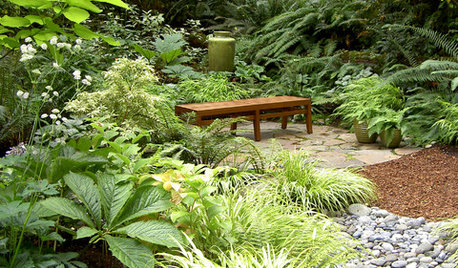



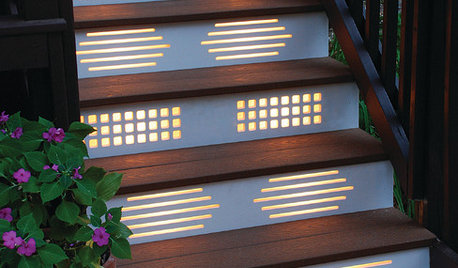
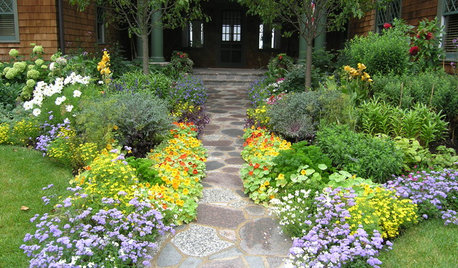








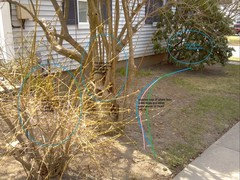
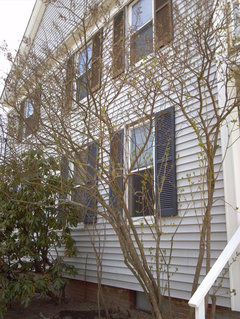


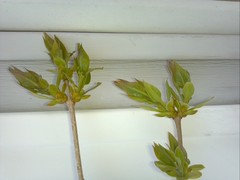

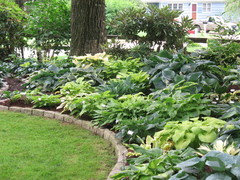
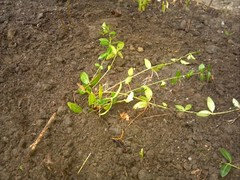

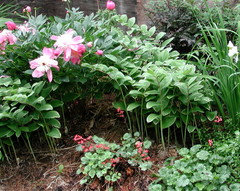
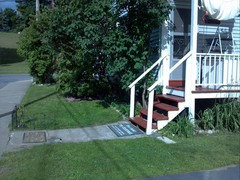
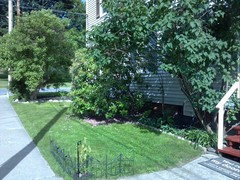
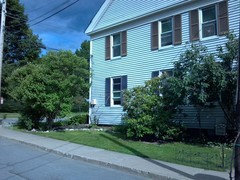
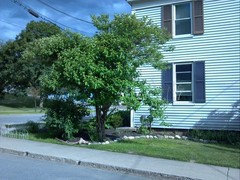

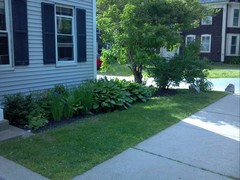

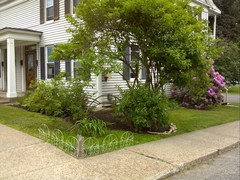
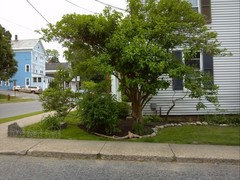


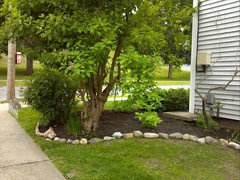
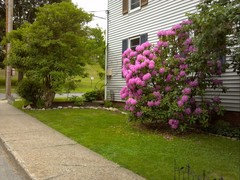
Jules (5a S.E. VT.)Original Author